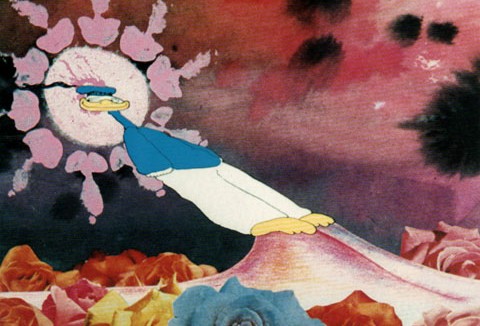
Down & Dirty Duck (1974) was the labor of love of Charles Swenson. Swenson, an animator affiliated with Fred Wolf, wrote, directed and animated Down & Dirty Duck for Roger Corman’s New World Pictures. The film was green lit in order to exploit the success of Ralph Bakshi’s features Fritz The Cat (1972) and Heavy Traffic (1973). Swenson had previously worked as an animator on Fred Wolf’s The Point! (1971) as well as Frank Zappa’s 200 Motels (1971) and was far more immersed in the counter culture and underground comics of the time than his mentor Wolf.
Down & Dirty Duck shares the visual aesthetic of Wolf’s The Point! and The Box (1967) but also incorporates photographic collage. Forms and shapes move fluidly through many metamorphoses in Down & Dirty Duck, following the trend of psychedelic art associated with filmmaker Lawrence Jordan and illustrator Pedro Bell. But the fantasy presented in Down & Dirty Duck is wholly derived from Bakshi’s films and Zappa’s music. Every day objects transform into male or female sex organs on a whim in Down & Dirty Duck so that one is immersed in the subjective psychosexual fantasies of the protagonist.
The film follows insurance claim adjuster Willard on his odyssey to get laid. Willard befriends the titular transgender Duck who becomes his guide to all things anti-establishment. Like Heavy Traffic, Down & Dirty Duck trades in racial stereotypes and misogynist jokes to lampoon both the political right and left of the moment. It’s problematic to be sure, even when couched in the interiority of the central character’s fantasies. This operation that pits the protagonist against the world is directly tied to the Jewish identity of the character Willard who does not see himself represented in the popular cultures of either the right or the left. This conundrum is central to Bakshi’s work as well.
This trope of the Jewish outsider on an absurdist, borderline surreal journey recalls Kafka’s The Trial but dipped in LSD in this case. Down & Dirty Duck takes down lesbianism, feminism, Black Power, John Wayne, militarism, and capitalism as Willard’s horny sub conscious wages war on his exclusionary reality. This is where the animated fantasias of Bakshi and Swenson diverge. Bakshi uses the perspectives of an individual to navigate and define a larger community made up of a diverse cultural milieu while Swenson ardently adheres to an “us and them” mentality rooted in a fetishized iconoclasm of individuality.
This focus on the individual within a social/sexual context is closer to the animated vignettes in Frank Zappa’s films. But for Zappa these vignettes work as asides that accompany songs and represent a glimpse into a character’s inner life away from the larger narrative and social complex of the film. Swenson zeroes in on this concept and transforms what would be an aside or interlude for Zappa into a feature length meditation on an individual’s anxieties. It’s no surprise then that Down & Dirty Duck is at its most coherent when Swenson is animating to an original pop song.
Since its initial release Down & Dirty Duck has drifted into obscurity. It’s a film dwarfed by the success of Fritz The Cat that came before it and Howard The Duck (the comic) that came after it. There is still a cultural value to this animated feature as a snapshot of a countercultural movement that, in today’s climate, would be utterly impossible. Still, it’s not a film for the unadventurous or the ill prepared.
